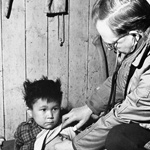TB Today: A Global Emergency
A National Perspective: TB in Canada
In Canada, in 2011, the incidence of any form of tuberculosis was only 5 per 100,000 according to the World Health Organization (WHO); this rate places Canada within the tier of 24 reporting countries with an incidence rate of 5 per 100,000 or less. Roughly 1,600 new cases of TB are reported in Canada each year.
Tuberculosis cases are annually reported across all regions of Canada, but the provinces and their inhabitants are not equally affected by tuberculosis. The majority of TB cases are reported in Ontario, British Columbia, Manitoba, and Quebec. Certain populations are more heavily affected than others, namely the Aboriginal, Inuit and Métis, as well as the foreign-born population, and certain regions have greater incidence of drug-resistance.
Drug-Resistant TB in Canada
In TB drug sensitivity tests conducted in Canada in 2010, 1.3% of samples tested were cases of Multidrug Resistant TB (MDR-TB) and 0.08% of Extensively Drug Resistant TB (XDR-TB). The percentage of drug-resistant cases among newly identified TB cases remained quite stable between 1998 and 2010, suggesting that Canada is doing an adequate job of identifying and treating drug-resistant strains, limiting their dispersal within communities; however, it must be recognized that with growing numbers of drug-resistant TB worldwide, we are guaranteed to see more cases in the coming years. Safeguards to ensure early diagnosis and appropriate treatment need to be ensured.
Drug-resistant cases have been identified in only seven provinces or territories between 1998 and 2010, specifically Ontario, British Columbia, Quebec, Alberta, Manitoba, Saskatchewan, and Nunavut. Of 216 identified MDR-TB cases, almost 60% were found in Ontario and almost 18% in British Columbia. XDR-TB has been reported in Canada.
Aboriginal, Inuit, and Métis Communities
Within Canada certain communities, such as Aboriginal and Inuit populations, have borne an unequal share of tuberculosis cases. For example, in 2008 the Inuit population had a TB incidence rate of 157.5 per 100,000 as compared to the non-Aboriginal Canadian-born population with a rate of 0.8 per 100,000 (see chart, below). This burden of TB cases existed historically and continues to exist today for reasons associated with the ‘social’ nature of TB, namely the overcrowding of many Native and Inuit residences (especially on-reserve), diet, problems with drug-abuse, and access to health-care.
| ORIGIN STATUS | # OF CASES |
INCIDENCE RATE (per 100,000) |
|
ABORIGINAL: Indian (status) Indian (non-status) Métis Inuit |
218 9 27 88 |
26.6 - 8.0 157.5 |
| CANADIAN-BORN NON-ABORIGINAL | 210 | 0.8 |
| FOREIGN-BORN | 987 | 13.4 |
| TOTAL: | 1600 | 4.8 |
Source: Table copied from House of Commons Standing Committee on Health, The Way Forward: Addressing the Elevated Rates of Tuberculosis Infection in On Reserve First Nations and Inuit Communities (2010), p. 3.
Canada’s Native populations were relatively untouched by tuberculosis before European contact through the fur trade began in the mid-to-late eighteenth century. As contact was made in different regions at different times, no one timeline of events describes the experience of all communities; however, generally speaking, it was not until the late nineteenth and early twentieth centuries that tuberculosis was ravaging Native communities in epidemic proportions. The disease spread initially because of low immunity to tuberculosis within Native communities. It continued to spread because of social conditions that benefited the pathogen, namely an upheaval of traditional lifestyles, including the creation of the reserve system, displacement, crowding, the loss of traditional food sources, and institutionalization in Residential Schools.
By the 1930s and 1940s the death rate among the Native peoples from TB was at least 700 per 100,000 annually, while within residential schools the rate was an astronomical 8,000 per 100,000 youth. These numbers are among the highest ever reported anywhere in the world.
Similarly, a 1945 report identified a death rate due to TB among the Inuit at 314 per 100,000. More than one-third of the Inuit population was infected with TB in the 1950s.
In the late 1940s and 1950s the federal departments responsible for Native health services increasingly sought out cases of tuberculosis for treatment in sanatoria. Similarly, departments responsible for Inuit health services sent out medical teams to northern communities on ships to screen the Inuit population for TB using x-rays. Identified cases of TB were removed from their communities, often with no chance to say goodbye to family or to set affairs in order, and sent to the south to be treated in sanatoriums. The culture-shock of this transition was immense. Native and Inuit patients had to deal with language barriers, a new diet, and strange living situations. Inuit children taken from their parents could spend years being raised in a southern sanatorium, only to be returned to their now-unfamiliar home communities with few language skills and little awareness of Inuit culture. Many other Inuit patients never returned home.
Today the Aboriginal peoples of Canada experience TB at a rate 32 times greater than that of the overall Canadian population, and the Inuit at a rate 186 times greater. Health Canada’s Strategy Against Tuberculosis for First-Nations On-Reserve seeks to improve TB prevention and control by working with First Nations communities and provincial agencies to improve case-finding, treatment adherence, and community awareness. While these are important steps, changes to the socio-economic status of Native and Inuit communities must also be enabled through government programs and policies.
Immigrant screening
65% of active TB cases in Canada occur in foreign-born residents of Canada, though this group makes up only 20% of the population. 80% of the TB cases in Ontario are found among foreign-born residents. The risk of developing active TB is twice as high among refugee claimants as among immigrant populations. These disproportionate experiences of TB are due to endemic conditions in the sending country, but are also exacerbated by the socio-economic strains that can often accompany immigration or claiming refugee status, such as stress, unemployment, and overcrowding. The risk of these populations developing active TB after migration drops dramatically after one year, but continues to be elevated throughout the life of the individual.
Canada has a well defined screening program for TB in immigrants, refugees, and temporary residents in the country for more than six months on work or study permits. All applicants are screened for active TB before entering the country. They must obtain a chest x-ray, which is reviewed for signs of TB by a physician in the sending country as well as by a physician in Canada or by an Immigration Medical Officer. If the x-ray shows abnormalities, a sputum culture is tested. Anyone diagnosed with active tuberculosis must show that they have received treatment and no longer present with positive bacteria cultures in order to enter Canada. Those presenting with inactive pulminary TB infections (approximately 3-5%) are allowed to enter the country but are required to participate in a Medical Surveillance Program aimed at reducing their future risk of disease. Several scientific studies have shown, though, that adherence to this program is suboptimal, with only 50% completing follow-up examinations and treatment. More work is needed to educate the public about the importance of such medical care and to limit the barriers to access.



